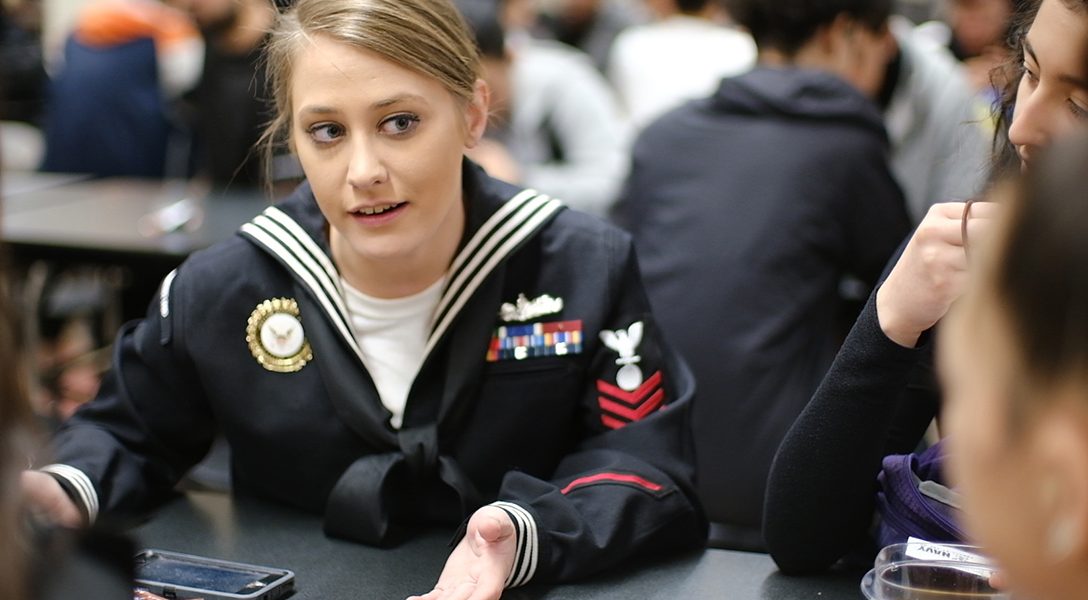Critics accuse US military recruiters of “predatory” practices that target the young and naive.
Air Force veteran Eddie Falcon enlisted as a teenager just before the September 11 attacks, partly to escape his violent Los Angeles County neighborhood. “I just didn’t see a lot of opportunities to succeed,” he said. Falcon assumed war “wasn’t something we were doing anymore.”
He ended up deployed to Iraq twice and Afghanistan twice, “getting trapped in another cycle of violence — just a different one.”
A few years after returning to civilian life, Falcon started talking to students about his experiences. A Hispanic man, he had witnessed persistent racism and rampant sexism. He also had had qualms about participating in wars he disagreed with.
“I want to tell young people the things that I didn’t know before I went into the military,” he said. “And things that I think a lot of people don’t know before going in.”
It’s no secret that military enlistment declines when the economy is strong, which means recruiters are scrambling once again to meet their quotas. A recent article from Army Times describes Army recruiting as a “grueling, frustrating job” that instills dread in anyone ordered to carry out that duty.
Preying Upon the Vulnerable
Recruitment also sets off an alarm among a much lesser-known group: “Truth in Recruitment” advocates. That’s because the low numbers appear to have recruiters doubling down on their targeting of teenagers — even those who have chosen to pursue higher education. Recruiters say teens are the most qualified age cohort. This may be true, but critics believe a key reason the very young are a choice quarry is because they are naïve and more easily persuaded than older people.
According to a 2016 Population Representation in the Military Services report, 17- to 20-year-olds comprise up to 80 percent of personnel in some branches. And the military appears to be mining data on even younger teens. A 2017 Department of Defense youth poll showed that 16-year-olds are even more attracted to military service than 18-year-olds.
In a recent Military Times op-ed, Shane McCarthy, the chief marketing officer of a tech company used by the military, argues that younger teens are also less likely to be disqualified by a criminal record, are cheaper to target with ads on social media, and come with the added bonus of being more likely to influence their friends.
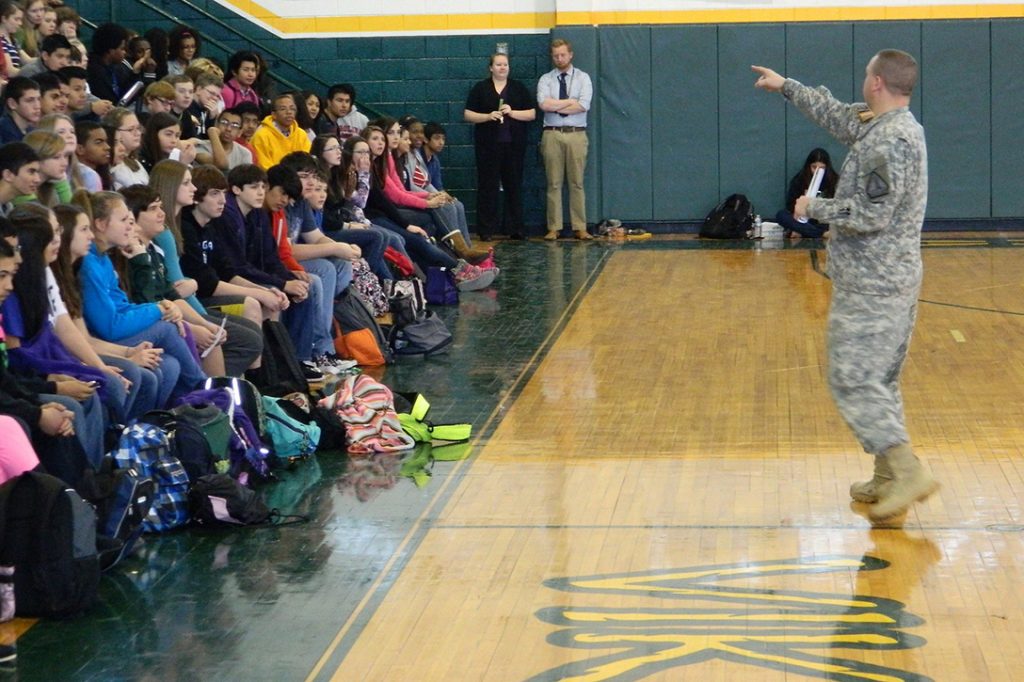
“It’s absolutely predatory,” said Malathi Iyengar, an assistant professor at the College of San Mateo. Two years ago, during her first semester teaching ethnic studies, she noticed the frequent appearance of recruiters on campus and thought she should warn students to be skeptical of what they often promised.
“I thought I would be doing some awareness raising, but they ended up educating me,” she told WhoWhatWhy. “The class erupted with these stories of siblings and cousins who had been lied to by recruiters. Then they started going into these stories of recruiters hounding them, following them, coming to their houses repeatedly. These were all working-class students of color.”
One student described climbing out of a back window to avoid yet another uncomfortable conversation with a recruiter. Another described being followed at a shopping mall (where recruiters consistently exceed enlistment goals), telling Iyengar he thought he was targeted because he is American Samoan, a group that serves in significant numbers in the US military, according to the Chicago Tribune.
But the story that bothers Iyengar the most is that of a young woman whom recruiters managed to discourage from pursuing higher education.
“A recruiter repeatedly called her, and when she told him she was going to college full-time, the recruiter would say things like this:
You won’t finish … you won’t get a job … you should join the military because that’s something you can really do something with.
“He was preying on legitimate worries that college students have.”
Every branch of the military has ethical guidelines and processes in place for addressing complaints. Captain Richard Chapman, company commander for four San Francisco Bay Area Army recruiting centers, told WhoWhatWhy he wants to know if any aggressive recruiters were on his team, so that he can address concerns. He says he has yet to receive complaints from College of San Mateo students or educators.
Iyengar says she doesn’t plan to pursue the matter because she doesn’t know if the recruiters who harass her students are the same as those on her campus, where she is confining her concerns.
https://www.youtube.com/watch?v=NhwMT768T64
“Recruiters hold a very special position,” said Chapman. “It’s a position of significant trust. You have to have a certain status just to be allowed to engage with people about the Army.”
Big Mistake: Trusting Your Recruiter
Those assurances don’t hold much weight for self-described Truth in Recruitment activists, who say recruiters have a long history of luring naïve teenagers into long, legally binding contracts with questionable tactics. No one knows the consequences of these unbreakable contracts better than longtime GI Rights Hotline counselor Siri Margerin.
“I have seen people suffer severe consequences for not doing their homework and for not understanding some of what is being suggested to them,” she said. “A big mistake is trusting your recruiter. They have a job to do, and it is not the same job you have to do.”
While the military claims its vetting process mostly weeds out the sort of person likely to suffer regrets after enlisting, Margerin says second thoughts are common among the recruits she knows.
“I have had countless sad experiences with talking to folks who are in their first week of basic training and are like ‘I have made the biggest mistake of my life. Get me out of here!’” she said. “They are desperate. Even kids who have dreamed about being in the military since they were six years old.”
She spends a lot of time with people calling from boot camp, working with them to try to build a path out of uniform that leaves them with their self-esteem intact. “They can come out really damaged,” she said. “It’s a huge blow to them, finding out that they can’t stand it. It’s emotionally debilitating. And they’re just at the beginning. It only gets harder.”
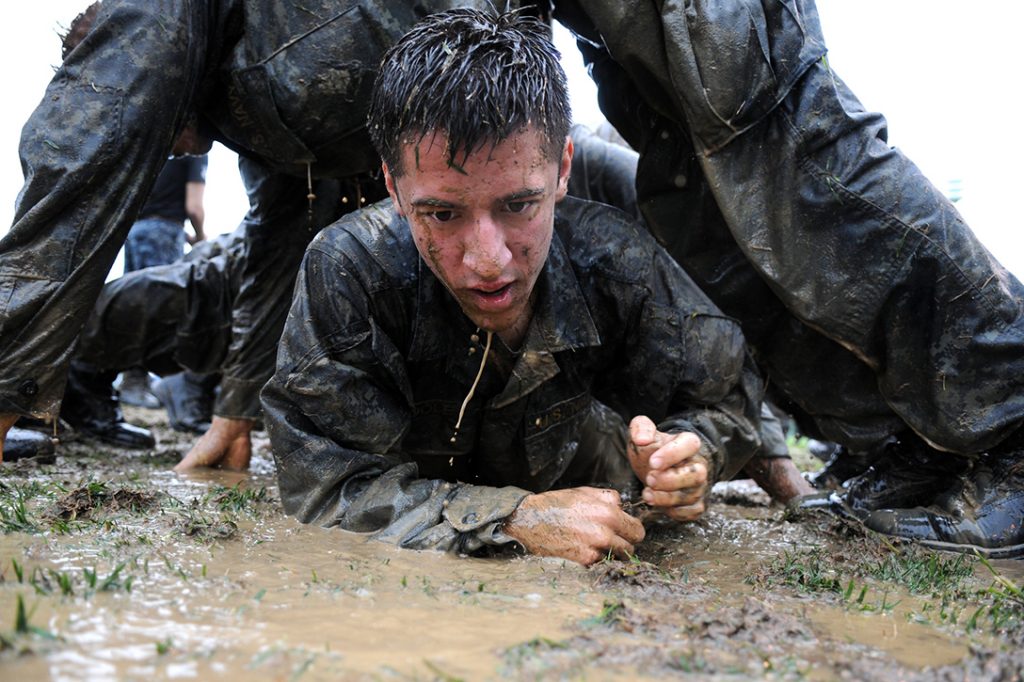
These stories drive Margerin to visit with activists like Air Force veteran Falcon. Most Truth in Recruitment members say they are not anti-military or anti-recruiter, but “pro-information.” They doubt that teenagers are equipped to make life-altering decisions, when science shows their brains are not fully developed. Right now, 17-year-olds can enlist with a parent’s permission.
A Recruiter’s Point of View
Chapman enlisted on his 17th birthday, in 2005. He sees recruitment in high schools and community colleges as a no-brainer. “They’re the most qualified population,” he said. “That’s the time in their life where they’re at a crossroads.”
He also says college isn’t necessarily the best option for many teenagers.
“High schools definitely push college, but then we do see quite a few drop out in their first or second year,” he said. “That’s where some of that negative perception comes in — that we come in and try to take students away. Most of the time it’s all about how can we help them reach their personal goals.”
Enter the problem of very unequal access. Under the federal Every Student Succeeds Act, signed by President Barack Obama in 2015, public high schools must provide the military with the names of all seniors, along with contact information, or risk losing federal funding. They must also grant recruiters access to campus once a month. Parents do have the right to “opt out” in writing from having their child’s information sent to military recruiters. But the law is weak. A single notice provided through a mailing, student handbook, or other method is sufficient. Consequently, most parents aren’t aware there’s an easy way to opt out. It’s not on their radar.
“We don’t get as much access as people think,” said Chapman. “Some schools won’t let us talk to anybody unless it’s that one time of the month. Some schools are much more open, and we visit them weekly. If a school is not in compliance with federal law, it’s usually a perception issue — that if you join the Army you’re going to have PTSD and you’re going to die. The perception isn’t the reality. For instance, right now, we’re focusing on STEM [science, technology, engineering and math] careers, which don’t have anything to do with combat.”
Only when pressed does Chapman concede that, no matter what your job, you are extremely likely to be deployed to a war zone in a time of war or conflict.
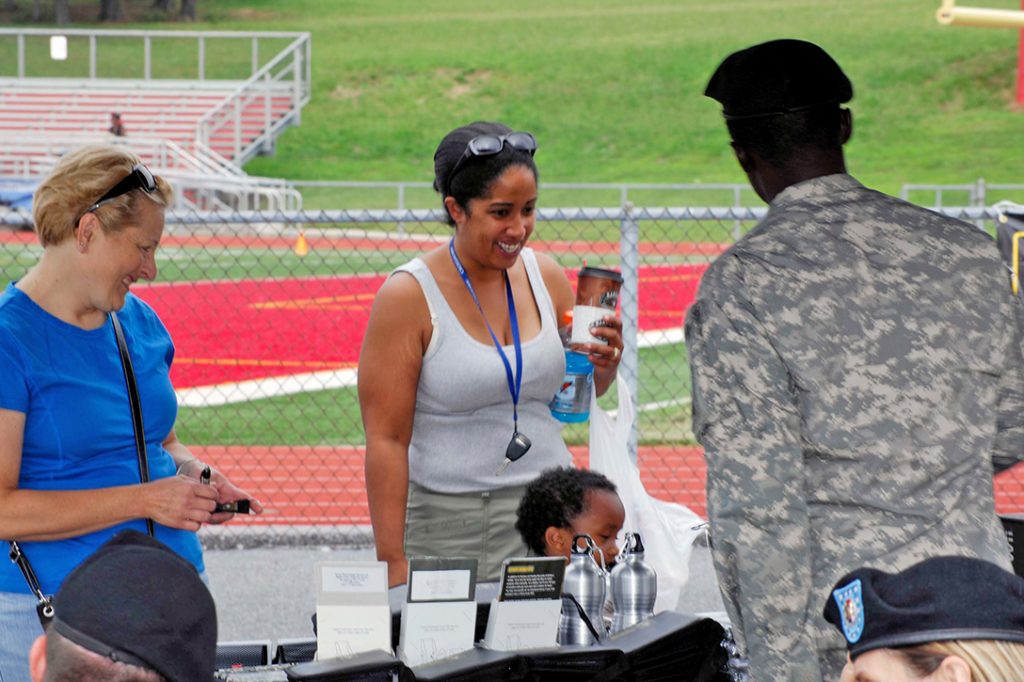
Obstacles to Telling Kids the Truth
Groups critical of current recruitment practices — like Before Enlisting, Stop Recruiting Kids, and the National Network Opposing the Militarization of Youth — struggle to gain access to schools at all. Their mission is to point out what recruiters don’t, such as that you are not guaranteed the job you sign up for, and every contract is technically eight years long. A recruiter isn’t likely to mention the potential for physical and moral injury — or the military’s long history of sexual assault and racism, or its high suicide rate, even though it concedes that these are problems.
“In most cases it’s not that people don’t want us,” said retired teacher Leni von Blanckensee, who now works with Before Enlisting. “It’s that teachers are just overwhelmed by the demands on them. You can send 10 messages and not hear back, and then someone will respond and ask: ‘Can you come Friday?’ Then the likelihood you and a veteran can drop everything and go is not so good.”
According to the Council on Foreign Relations, California brings in more recruits than any other state. While activists rely on donated time and donated materials to reach kids, recruiters are backed by a huge budget and go out of their way to appeal to educators. Chapman says his recruiters take high-school teachers and administrators every year to NASA’s impressive Moffett Field in Santa Clara County, and to the prestigious Defense Language Institute in Monterey.
“We also have a trailer coming to Fleet Week,” said Chapman, referring to a weeklong military event that draws hundreds of thousands to San Francisco’s waterfront each fall. “Everybody going to Fleet Week that goes on the Marina Green will see us with the Marines, with the Navy, demonstrating the roles in humanitarian assistance that the military provides.”
Compounding the issue of visibility and access, according to Margerin and von Blanckensee, is a lack of awareness by schools. Under that same Every Student Succeeds Act, public schools must grant access to groups offering narratives critical of military contracts and service. However, educators often don’t know about the rule, or are too busy, or simply do not want to wade into controversial waters.
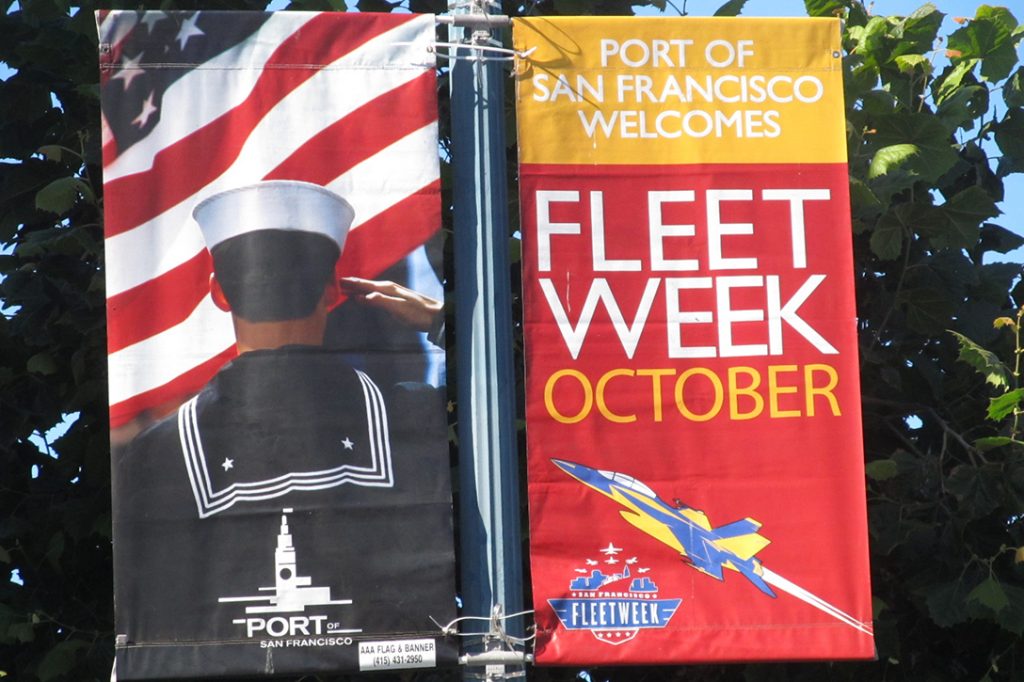
Von Blanckensee describes one administrator, who she believed was an ally, suddenly reversing course. “She says ‘I was always very much against having military recruiters at school, but to be frank, my niece couldn’t figure out how she was going to pay for college and she signed up. I now see the advantage and I don’t want to discourage kids from having access.’”
It didn’t help matters when Von Blanckensee tried to explain that she wasn’t telling teens what to do, but only wanted to make them aware of both sides of the issue.
“Military folks are just walking onto campus, not asking for permission, and talking to kids. We can’t do that,” said von Blanckensee. “That’s the frustration. It’s important for kids to know both sides of the story. We know they’re getting the military side of it.”
The Stigma of Dissent
It’s a frustration Falcon shares. He feels that students, parents, and educators have been primed to think a certain way about recruiters and military service.
“The biggest thing is the culture in America. [People] see that uniform, and they think ‘yeah, go talk to the kids. You’re serving our country.’ No one wants to question that because there’s a stigma attached to dissent. What, are you un-American? Unpatriotic? But not everybody who wears a uniform is some pure war hero. We have to remember that their job is getting kids into the military. And they have so many resources to do it. They definitely have an advantage.”
Educators like Iyengar, who are disturbed by the disparity and by what recruiters are telling students, are at a loss for a response. She is especially concerned because the College of San Mateo, like many community colleges, also serves high school students, some as young as 16.
“I don’t see any way for us as faculty to hold them accountable,” she said, noting that recruiters appeared on campus on the first day of this year’s fall semester, right in front of the student center. “I can’t directly tie the stories of bad behavior my students told me to the recruiters who visit our campus. It would take a complaint, or several, lodged by students to get them off campus, and then it’s just that one recruiter who wouldn’t be allowed back.”
On her own, Iyengar reached out to Before Enlisting and the Oakland youth-led group BAY-Peace to try and arrange speakers to raise awareness. But students, parents and teachers concerned about these issues in other regions don’t have these resources.
Veterans who have distanced themselves politically and morally from the wars in Iraq and Afghanistan often frown at the term “all volunteer” military. Many, including Falcon, see themselves as products of the so-called economic draft. And they wish they had been a little wiser about the world before enlisting. According to a 2016 Population Representation in the Military Services report, 17- to 20-year-olds comprise up to 80 percent of personnel in some branches.
If the goal is to truly create an “all volunteer” force, where recruits don’t regret decisions they make as teens, critics of current recruitment strategies argue it may be time for the government to reconsider whom recruiters target and where and what they say to them.
Rosa del Duca is a veteran, conscientious objector, and author of Breaking Cadence: One Woman’s War Against the War, which chronicles her journey from eager recruit to unlikely rebel. She has a companion podcast, Breaking Cadence: Insights From a Modern-Day Conscientious Objector. She may also become a Truth in Recruitment activist soon.
Related front page panorama photo credit: Adapted by WhoWhatWhy from Official U.S. Navy Page / Flickr.
